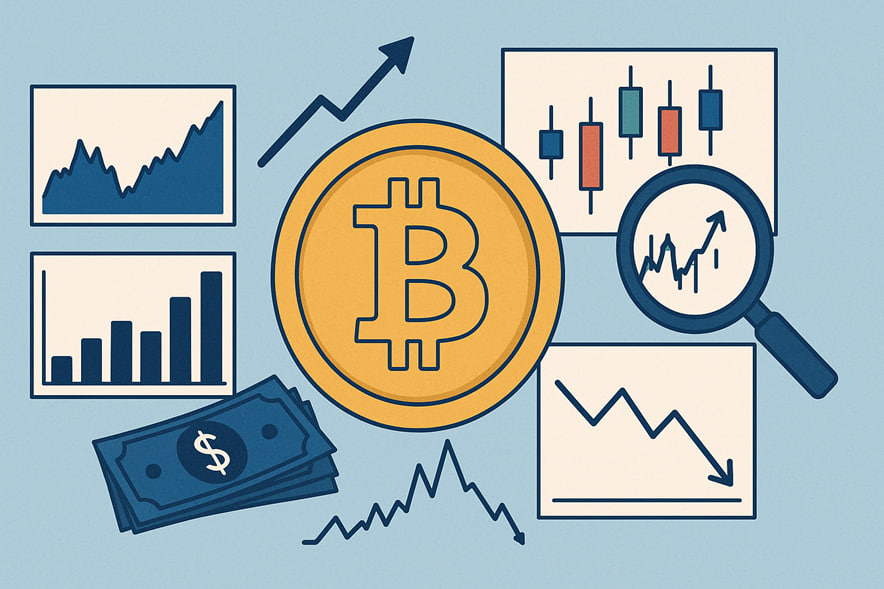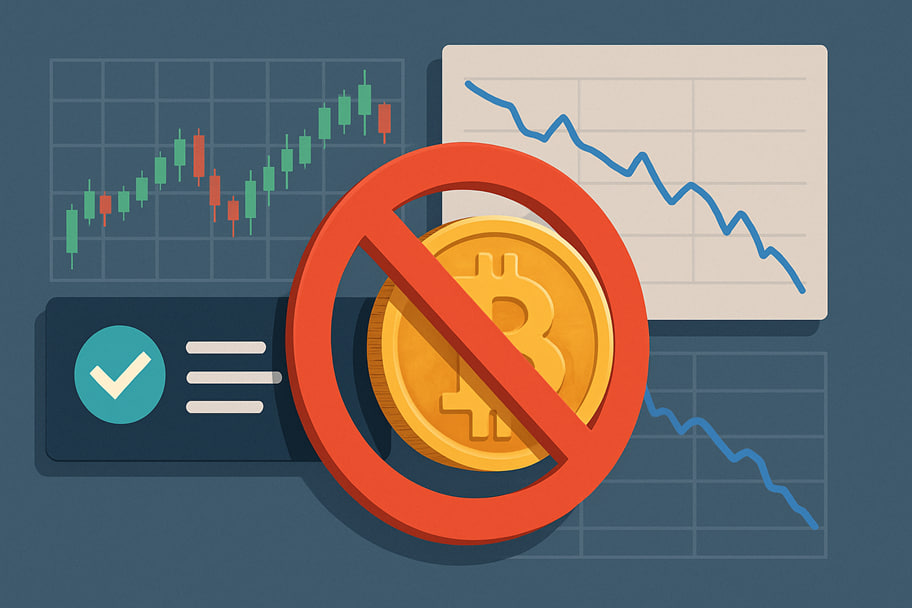Trading CME Bitcoin Futures: Strategies and Insights

Contents
- Introduction
- Overview of CME Bitcoin Futures
- Connection with “Traditional” Bitcoin
- Primary Strategies for Trading CME Bitcoin Futures
- Arbitrage Between CME and the Spot Market
- When It Works
- Risks and Technical Complexities
- Trend Trading
- Using Technical Analysis Based on the Spot Chart
- Which Indicators Work Best for Futures
- Hedging a BTC Portfolio via CME
- How Institutional Players Hedge Risk
- Is It Suitable for Retail Investors
- Trading on Expected Volatility
- Impact of Macro News and Events on Futures Prices
- Using Options Strategies in Combination with Futures
- Arguments in Favour of Tracking Traditional BTC
- Counterarguments: When Not to Rely on Spot
- Conclusion
Introduction
What Are Bitcoin Futures on CME
Bitcoin futures on the CME exchange are cash-settled contracts in US dollars based on the CME CF Bitcoin Reference Rate (BRR), which serves as a once-a-day reference rate for the price of bitcoin in USD.
CME stands for the Chicago Mercantile Exchange, one of the world’s most liquid and respected trading venues. Through a regulated exchange, institutional investors, large funds, and banks can now trade bitcoin in a familiar format.
How CME Bitcoin Futures Differ from Regular Bitcoin Trading
Regular bitcoin trading takes place on crypto exchanges, where users buy and sell the actual asset. This is known as spot trading. When someone buys bitcoin on a spot exchange, they become the coins’ owner. They can transfer them to their wallet, sell them later, or hold them.
Futures work differently. There is no physical ownership of Bitcoin. Participants open and close positions for profit or loss. Trading is done with contracts, not actual coins.
CME futures are also traded on weekdays only, unlike crypto exchanges, which operate 24/7. There are specific session openings and closings, which create differences in charts and price movements.
Why Traders Need Strategies and Why It’s Important to Track Spot Bitcoin
Trading without a strategy is a game of chance. In the crypto market, this often leads to losses. CME futures behave somewhat differently from the spot market. The price can diverge, especially during strong moves or at the close of a trading session. Therefore, a trader needs to understand what to focus on.
One key question is whether to monitor the behaviour of spot Bitcoin when trading on CME. After all, most trading volume and liquidity reside on crypto exchanges, where the real market price is formed. CME often “lags behind” or “anticipates” these moves. Sometimes, differences between the two markets appear, which can be used in trading.
A trader needs to see how spot bitcoin behaves. It helps assess market sentiment, forecast future price movements, and open or close trades on time. Without accounting for this connection, strategies may underperform, so whether to track spot bitcoin while trading futures is entirely logical and essential.
Overview of CME Bitcoin Futures

Contract Specifications: Lot Size, Expiration Date, Settlement in Fiat
Bitcoin futures on CME have clear rules. One contract equals five bitcoins, which is a large volume, so such trades are primarily suitable for big players. There are also micro contracts—0.1 BTC each—that are more convenient for traders with smaller capital.
Each futures contract has a term—it cannot be held indefinitely. CME offers contracts with various expiration dates: the nearest month, the next month, and quarterly. When the expiration date approaches, the trader either closes the position in advance or rolls it over to the next contract—sells the current one and buys a new one with a later date. Formally, contracts close automatically at expiration, but in practice, almost no one holds a position until the last moment—they close or roll it over in advance to avoid excess volatility and settlement procedures.
The main difference between these futures and futures is the USD settlement. This means no one receives actual bitcoin. Instead, CME calculates the trader’s profit or loss and transfers the amount in fiat currency.
Key Market Participants: Institutions vs. Retail Traders
CME is primarily a platform for institutional market participants, including banks, hedge funds, and asset managers. These players deal with large sums of money and apply well-developed strategies. They manage risk and often use futures for hedging to protect against sharp price fluctuations.
Retail traders can also trade on CME, but they are few and far between. The reason is the high entry threshold. Even a micro contract requires significant capital and knowledge. Additionally, the exchange imposes strict requirements on brokers and platforms, making access more difficult for newcomers.
Institutions tend to move the market more often, as they have more capital and can open prominent positions. However, retail traders remain essential, especially during periods of high volatility.
The Role of CME in Price Formation and Market Influence
Although most bitcoin trading occurs on crypto exchanges, CME still influences the market. CME prices are often used in reports, indices, and institutional products such as funds or options. Therefore, CME quotes become a benchmark for many market participants.
Moreover, CME helps popularise cryptocurrencies in society. Thanks to its straightforward rules and regulatory oversight, it attracts investors who previously avoided crypto assets.
When many long or short positions are opened on CME, this can influence the spot bitcoin price. This is especially noticeable during contract expiration, when participants lock in profits or losses. Such moments often cause sharp price movements on the chart.
Connection with “Traditional” Bitcoin
Spot BTC Market as an Indicator: How and Why It Influences Futures
The spot market is where people buy and sell actual bitcoin. It is the foundation of all crypto trading. This is where the real price of the asset is formed.
CME futures don’t operate in isolation from spot. On the contrary, they almost always mirror the movements of the real bitcoin price. When bitcoin rises on the spot market, futures go up too. When the price drops, futures follow. This happens because the current asset price guides futures market participants.
Additionally, the spot market allows a quick assessment of crowd sentiment. If strong demand appears, it can signal institutional traders on CME. They may open positions in the same direction as the majority to avoid missing the move.
Data Analysis: Discrepancies and Arbitrage Between CME and Spot Prices
Sometimes, the future price of bitcoin differs from the actual price. This is called a discrepancy. It can be higher or lower. It occurs when future market expectations don’t align with current conditions on the spot market.
For example, if traders believe bitcoin will rise in a month, futures may cost more than spot bitcoin. This is called “contango.” If the market expects a decline, the futures may be cheaper. That’s “backwardation.”
Arbitrage traders profit from these differences. They buy where it’s cheaper and sell where it’s more expensive. As a result, the discrepancy usually disappears quickly. So even when CME and spot prices diverge, they remain tightly linked.
Impact of Trading Hours: 24/7 BTC Market vs. Limited CME Schedule
Regular crypto exchanges operate nonstop, 24/7. This is convenient but creates differences with CME, which has a fixed schedule. Futures trading on CME is not around the clock.
This leads to situations where the spot market has already moved up or down, but CME hasn’t opened yet. When the session begins, the futures price may be in a gap to catch up with the spot.
CME also has weekend breaks. If major events occur during these breaks, spot traders will already react, while the futures market remains frozen. When CME reopens, all accumulated expectations are immediately reflected in the price, which can cause strong volatility.
Therefore, traders should monitor spot bitcoin, even when trading only futures. Spot often gives clues about where prices will move after the break.
Primary Strategies for Trading CME Bitcoin Futures

Arbitrage Between CME and the Spot Market
Sometimes, the price of Bitcoin futures on the CME exchange differs from the actual Bitcoin on regular crypto exchanges. If the difference is significant enough, traders can take advantage of this. They buy the asset where it’s cheaper and sell it where it’s more expensive. This creates an opportunity to profit regardless of whether Bitcoin rises or falls.
This method is called arbitrage. It works when the market discrepancies exceed transaction fees and other expenses. Arbitrage helps align prices across platforms and contributes to market stability.
When It Works
Arbitrage performs well when the spot market moves faster than the futures market or vice versa. This often happens during strong news events when prices begin to shift rapidly. Arbitrage also works better when liquidity on both platforms is high—that is, when many people are trading and transactions execute without delays.
Risks and Technical Complexities

Although arbitrage may seem simple, it comes with many practical challenges. You need to have accounts on both a crypto exchange and the CME. It’s also crucial to act quickly before the price difference disappears.
There’s also a risk that an order may not execute on one of the markets, leaving you with an open position and a potential loss. Fees must also be taken into account. Additionally, arbitrage requires fast connections to exchanges, reliable hardware, and constant monitoring.
Trend Trading
Another popular strategy is trend following. A trader simply opens a position in the same direction as the market. If Bitcoin is rising, they buy futures. If it’s falling, they sell. This strategy may seem simple, but requires discipline and understanding of office behaviour.
Using Technical Analysis Based on the Spot Chart
Many future traders will monitor the price chart of actual Bitcoin. This helps them understand the overall direction of movement. Since futures tend to mirror spot behavior, spot market signals often lead to CME movements.
For example, if the spot chart shows a breakout of a key level, it may indicate the start of a strong move. The trader can take a futures position in advance and profit from that move.
Which Indicators Work Best for Futures
Simple indicators that show trend direction and overbought or oversold levels are well-suited for futures. These may include the Moving Average (MA), Relative Strength Index (RSI), or support and resistance levels.
It’s also worth watching the trading volume on the spot market. It shows how strongly market participants are supporting the current move. The higher the volume, the more reliable the trend.
Hedging a BTC Portfolio via CME
Bitcoin futures are often used not just for speculation but also for risk protection. If someone holds a large amount of Bitcoin, they can open an opposing position on CME even if profits on the futures may partially or wholly offset the price drops sharply, the loss on Bitcoin. This is called hedging.
How Institutional Players Hedge Risk
Significant funds and companies holding Bitcoin don’t always want to sell during price drops. Instead, they open short positions in the futures market. This helps preserve asset value and protect investors from sharp drawdowns.
Hedging is a standard tool for institutional investors. They use it routinely in traditional markets and apply it to cryptocurrencies.
Is It Suitable for Retail Investors
Retail traders can also use futures for protection. But there’s a caveat: futures require a solid understanding of the market, discipline, and proper position sizing. Without experience, increasing losses rather than reducing them unintentionally is easy.
That’s why beginners are better off practising on demo accounts or with small amounts before using futures for hedging.
Trading on Expected Volatility
Sometimes a trader doesn’t know which direction the market will go, but is confident there will be strong movement. In such cases, they can profit from volatility. This strategy focuses not on direction but on the strength of price movement.
If a sharp rise or fall is expected, the trader can open positions that profit in either scenario. The key is for the price to move significantly.
Impact of Macro News and Events on Futures Prices
Futures prices often react to economic news, central bank decisions, corporate reports, and other significant events. For example, news of rising inflation in the U.S. may instantly affect trader sentiment. Depending on how the news impacts Bitcoin demand, they begin buying or selling futures.
Traders monitor the calendar of important events in advance. This helps them act quickly and accurately.
Using Options Strategies in Combination with Futures
Some advanced traders combine futures with options. They use options to protect against losses or to increase profits. For example, one might buy a futures contract and simultaneously purchase an option to limit potential loss, giving greater risk control.
These strategies are more complex and require experience. However, they allow for flexible position management and adaptation to various market scenarios.
Arguments in Favour of Tracking Traditional BTC

BTC/USD on the Spot Market as a Leading Indicator
Most Bitcoin trading occurs on the spot market, where traders buy and sell “real” Bitcoin, not contracts. Most price movements originate there.
When spot Bitcoin starts to rise or fall, futures almost always follow. That’s why the BTC/USD chart on the spot market often provides the first signal. If a trader notices a reversal or a breakout on the spot chart, they can use this information to open a position on CME.
Futures respond quickly, but the spot sets the direction. So traders watch BTC/USD price closely, even when trading futures.
Volumes and Liquidity: Where the Movement Begins
Trading volume and liquidity are crucial factors. Where there are more participants and trades, price movements carry more weight.
Volumes are generally higher on the spot market, where retail traders, funds, large players, and algorithms all participate. Key levels—support and resistance—often form there first, later influencing futures.
If a large volume appears on the spot, it may signal the start of a strong move. Futures respond afterwards. That’s why it’s essential to understand where demand or supply appears — it helps make proactive decisions, not just follow the market.
Crowd Psychology and Retail Market Reaction
Many traders make decisions based on emotions. Some fear missing out on gains, and others panic sell. All of this is visible primarily on the spot market.
Retail participants usually don’t use complex strategies. They react to news, rumors, and strong price movements, creating sharp spikes that are noticeable on the spot and influence futures.
Understanding crowd behaviour helps read the market better. If it’s clear that most retail traders are buying without a plan, a pullback may be near. If panic is excessive, a reversal could be expected. All this is first visible on the spot market.
Counterarguments: When Not to Rely on Spot

CME Can “Play by Its Own Rules”
CME Bitcoin futures do not trade around the clock. They have a defined schedule. If the spot market moves significantly over the weekend, CME futures will open with a price gap.
Such a gap isn’t just a void on the chart — it often confuses. Beginners might think CME always lags behind spot, but CME simply wasn’t trading at the time.
Algorithmic Trading and Other Market Distortions
CME is primarily populated by large participants, many of them funds and market makers. These participants use complex algorithms that can react to events in fractions of a second and spot weaknesses in other traders’ strategies.
Sometimes the futures price behaves oddly. For example, there might be a sharp move without an apparent reason. This is not related to the spot market but caused by bots or internal institutional strategies.
In such cases, the link between CME and spot weakens, which can confuse those who rely solely on the traditional BTC/USDT chart.
Example: Futures Can “Lead” the Spot Under Certain Conditions
Sometimes, the reverse occurs — futures move before spot. This happens when a large player begins building a position on CME in advance. Their actions can move futures prices even though nothing has happened on the spot yet.
Another example is an anticipation of significant news. Futures market participants might price in expected reactions ahead of time. They move prices up or down in anticipation. The spot market may react later.
This behavior shows that CME is not just a mirror of the spot. It’s a separate market with its logic. In some cases, watching the spot chart may even be misleading.
Conclusion
The BTC Spot Market Is an Important Reference, But Not the Only Factor
The spot Bitcoin chart truly helps to understand general market sentiment. It shows how participants behave in exchanges where the asset itself is traded. This can be useful for finding entry and exit points, especially when considering volume and price movement.
But relying solely on spot is a mistake. CME futures have their own characteristics—different participants, goals, and behaviours. Sometimes, they lag behind spot, sometimes they lead, and at times, they even move in the opposite direction.
Recommendations: Combine Analysis and Strategies for Effective Trading
To avoid traps, it’s important to monitor both markets—spot and futures. Spot may provide a clue about key levels, and CME shows how large players react to those levels.
A good idea is to avoid choosing a single approach and instead combine different methods. You can use the spot chart to determine direction and validate it on CME — or vice versa: track large futures trades and observe how spot reacts.
Final Point: CME Bitcoin Futures Are Not a Mirror of BTC, But an Independent Instrument With Unique Dynamics
CME Bitcoin Futures are not just a copy of regular Bitcoin. They are a standalone instrument with their schedule, rules, and participants. Sometimes, they behave like spots, but sometimes, they behave differently.
That’s why they should be treated as a separate market. Don’t expect them always to mirror Bitcoin’s moves, and don’t build strategies solely on that assumption.
Those who understand the differences between these two markets and know how to use them together have a better chance of success.